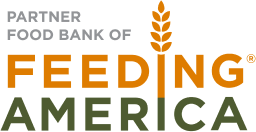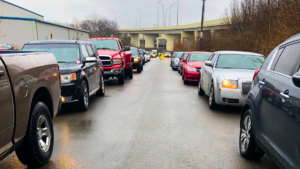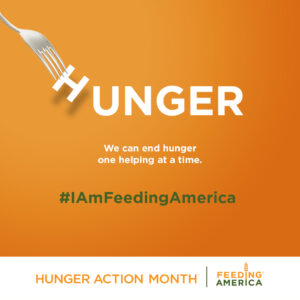Where our food goes
We distribute food through agencies and programs of all shapes and sizes
By: Emily Gallion, Grants & Metrics Manager/Advocacy Manager, and Caitlyn McIntosh, SNAP/Outreach Lead
Last fiscal year we distributed close to 18 million pounds of food. The last time we talked to you, we gave you the rundown of where we get our food from – but where in the world does 18 million pounds of food go?
Partner Agencies
The heart of The Foodbank’s hunger relief programming is the acquisition and distribution of food to our 116 partner agencies. This is the critical difference between a food bank and a food pantry: While a pantry distributes food to individuals, a food bank’s central mission is to distribute food to other organizations. Without the hard work of our agencies, we could not reach the 935,404 individuals we served last fiscal year.
Partner agencies fall into five categories: pantries, meal sites, congregate programs, emergency shelters, and Kids Cafe meal sites.
Food pantries: Also known as grocery programs, food pantries make up the majority of our partner agencies. A pantry is any program that distributes groceries for clients to prepare at home. Last year, we provided food for 96 such organizations. Our pantries vary widely in size and type, from small church pantries to larger nonprofits that serve thousands each month.
Hot meal sites, congregate programs, and emergency shelters: Sometimes referred to as soup kitchens, hot meal sites include any organization that provides free meals to anyone who needs it. Some emergency shelters, which include domestic violence shelters and temporary housing for people in crisis, also receive food from us. Last fiscal year, we served 22 hot meal sites and shelters.
Kids Cafe meal sites: The Foodbank operates a Kids Cafe program that is administered by a variety of community partners, such as after school programs. The Kids Cafe program serves meals to children in the community. Kids Cafe is a registered trademark of Feeding America.
Drive Thru
The Foodbank operates a Drive Thru Food Pantry to meet the additional needs of our local community. The Drive Thru was originally conceptualized as a way to distribute senior boxes. It has since grown into a service for the greater community.
Visitors to our Drive Thru are entered into our client management system, PantryTrak. Our data, which includes attendance at our direct service programs and partner agencies, is reported on a monthly basis to the Ohio Department of Jobs and Family Services. Fluctuations in attendance at our programs can act as a barometer to identify changes in regional food insecurity.
To receive food from the Drive Thru, you must bring a drivers license and have an income at or below 200% (or 230% during the COVID-19 pandemic) of the federal poverty limit.
Food distributed at our Drive Thru is intended to supplement any food received at our partner agencies and through the Supplemental Nutrition Assistance Program (SNAP). As such, clients may not receive a complete set of groceries, but will receive a variety of food such as fresh produce, frozen meat, and bakery items.
As of December 2020, The Drive Thru is open Monday thru Wednesday from 1pm to 3pm. Hours are subject to change; check this page for more up to date information.
The Foodbank Mobile Farmers Markets
Every month, The Foodbank’s Mobile Farmers Markets deliver fresh food and produce to 15 locations at high risk for food insecurity. These locations are in areas of high poverty that do not have access to a local food pantry. Many of our clients served by the Mobile Farmer’s Markets are seniors who are homebound.
Our Mobile program also operates on a larger scale when we host Mass Distributions throughout the year. Typically we host three a year: one in Montgomery county, one in Greene county, and one in Preble county. Due to the coronavirus pandemic and an increased need for food across the board, we hosted seven mass distributions this year. Stay tuned to our social media pages for our 2021 Mass Distribution schedule.
Last year, we distributed 1.8 million pounds of food through our Mobile Farmers Market programs.
To view our mobile schedule, visit http://thefoodbankdayton.org/agencies/needfood/.
Senior Boxes
The Commodity Supplemental Food Program, better known as the Senior Box Program, is a federally funded program that provides seniors aged 60 and over a monthly box of food items catered to their dietary needs.
The Foodbank distributes just over 1,000 of these boxes each month at 16 different locations, including our on site drive thru.
For a deep dive on senior hunger, check out our blog post. Senior box qualifications and the application can be found here or by calling 937-461-0265 ext. 17.
Good to Go Backpacks
These meal packs are given to food insecure children who qualify for free or reduced-cost lunches during the week, but are at risk of going hungry on weekends.
Students who are enrolled in this program receive a pack of healthy, kid friendly food that is discreetly placed in their backpacks every Friday. School personnel select students to participate based on signs of hunger, such as rushing lunch lines, hoarding food, and talking about not having food at home.
Each backpack also contains a “love note” with an uplifting personal message and information regarding our emergency food line. This phone line is operated 24 hrs a day for families in need of immediate assistance. Our staff member will refer the caller to a partner agency or Foodbank program near them.
Last year, we had 1,520 students in 30 schools who participated in the program.
Rx Boxes
The Foodbank, in partnership with Dayton Children’s Hospital, created a Food Script Program that allows physicians and staff to write food prescriptions for hospital patient families who have been identified as food insecure.
The food insecurity screenings are conducted by hospital community health workers, social workers, nurses, and staff. The primary target audience for this project is families with children who may be food insecure but are not already receiving food assistance.
Last year, these Rx Boxes were distributed to 522 households.
If you or someone you know is in need of food assistance, check out our overview of resources here. We also frequently post resources and up-to-date food distribution information on our Facebook page.





No comment yet, add your voice below!